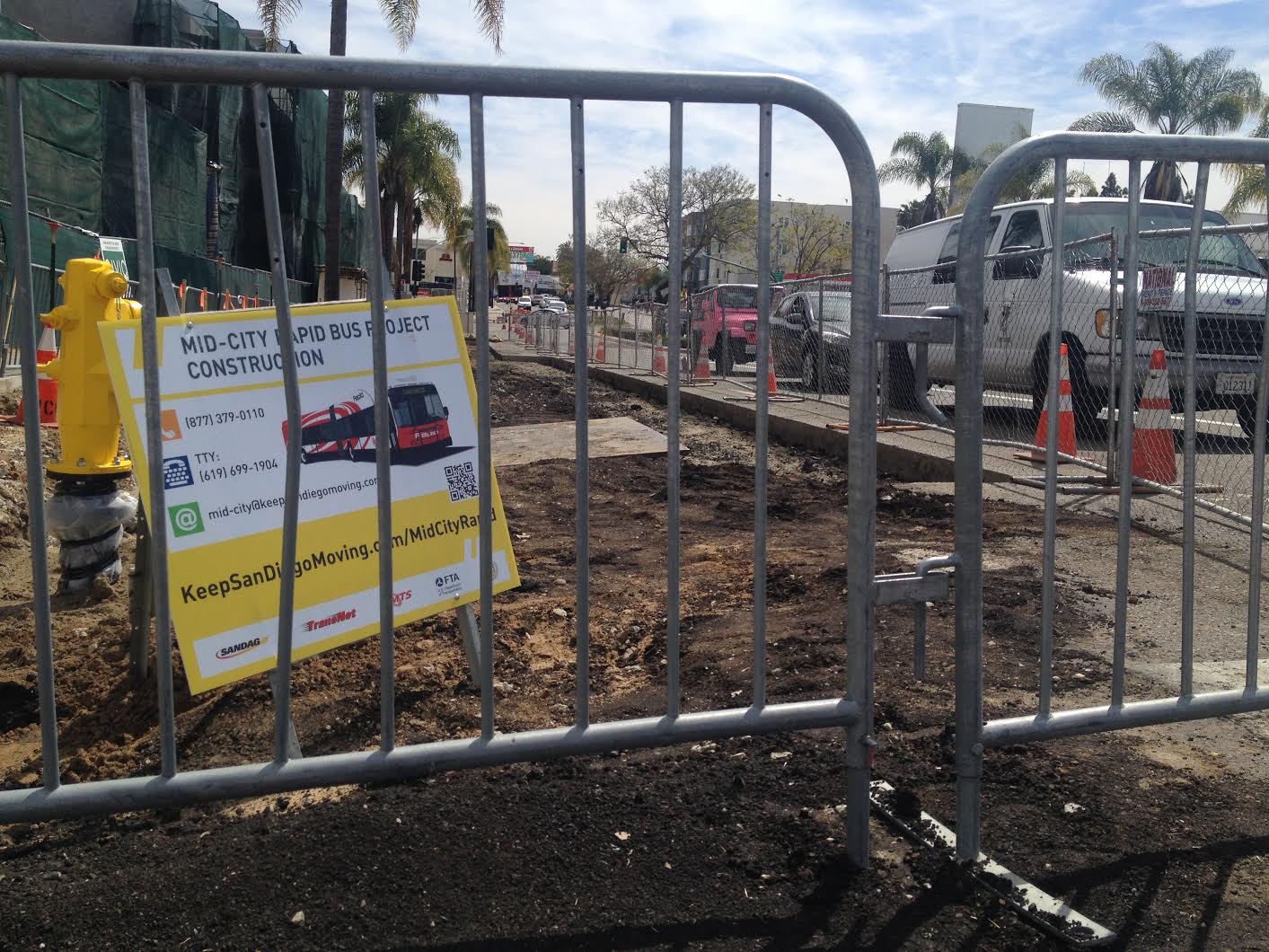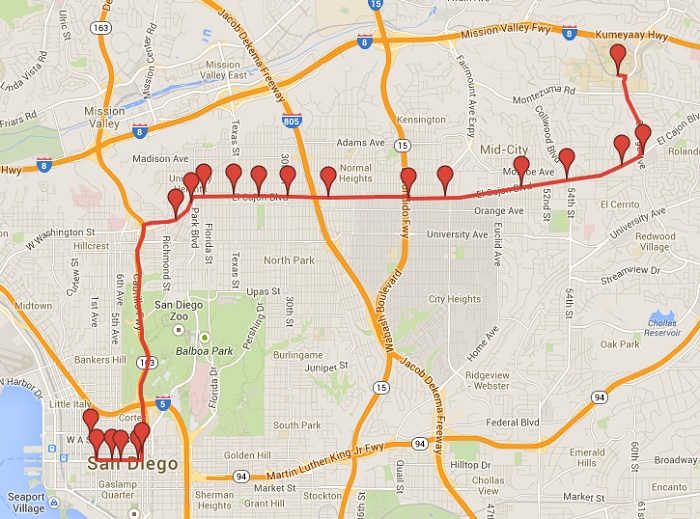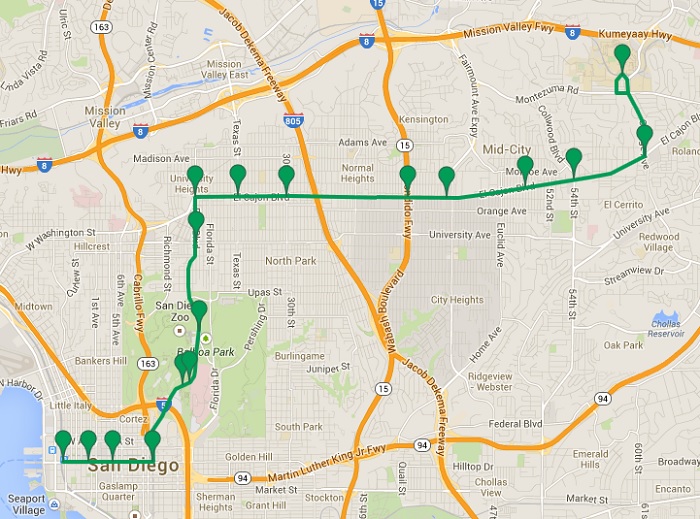
Construction on the Mid-City Rapid bus line begins at El Cajon Boulevard and Fairmount Avenue in City Heights. | Photo Credit: Megan Burks
San Diego has invested heavily in a new transit service, meant to be more attractive than traditional buses, by mimicking the frequency and convenience of rail.
But not everyone loves “The Rapid.” One common complaint is that investment in BRT is a cop-out. If you want to give people high-quality transit like the trolley, get serious and build a trolley line, they say.
There’s another argument against the Rapid, too, and specifically against the line set to run from San Diego State University through mid-city and into downtown: Planners aren’t even building the scaled-down service they say they’re building. All they’re building is a glorified express bus, but the new line doesn’t really save a meaningful amount of time.
It comes up often, so we wanted to expand on how much time the project actually saves, and put in context how relevant those time savings might be.
First things first, let’s look at the schedule.
There’s currently a regular, local bus line that connects SDSU to downtown, the 15. The travel time for that route varies. If you leave downtown around 5 p.m. on a weekday, you’re looking at a 49-minute trip to SDSU. If you leave around noon it’s more like 46 minutes. At 8 a.m. it’s 44 minutes; at 6 a.m. it’s 34 minutes.
The times vary if you’re going the other direction, too. It’s about 33 minutes going from the SDSU Transit Center to downtown at 6 a.m. It’s 42 minutes at 8 a.m., 46 minutes at noon and 44 minutes during the 5 p.m. rush hour.
During the times when most people are traveling, the trip takes between 42 and 49 minutes.
The new rapid service is expected to have a 38-minute trip time. It’ll run every 10 minutes in peak periods and every 15 minutes in off-peak periods.
Dave Schumacher, principal planner for SANDAG, the region’s transit planning authority, acknowledges The Rapid isn’t running yet, so 38 minutes is just an estimate. The line is set to open at the end of August.
Accepting the estimate would mean you’re looking at a 10 to 22 percent reduction in overall travel time at peak hours, or a time savings of four to 11 minutes.
There’s enough room there for people to come to a range of conclusions. Cutting out 22 percent of your commute is pretty substantial, and there’s a limit to how much time could be saved even with a rail line. Taking the trolley from SDSU to downtown on the green line, which goes through Mission Valley and Old Town, takes between 30 and 41 minutes, depending on the stop. When you look at it through the minutes-saved lens, though, four minutes on the low end isn’t a very big deal at all.
There are other factors to consider.
For one, those savings are from the very first stop to the very last stop. Most riders will be taking the bus for some shorter distance in between.
That’s where planners think the overall time savings doesn’t reflect all the other ways they’ve improved the area’s transit service. Adding destinations, they say, is part of the improvement.
“There’s always tradeoffs,” Schumacher said. “You’ve got a stop at the Naval Hospital there too, so you get people coming there for employment, too and that’s a big benefit, while you lose use of the freeway.”
The 15 line begins at SDSU and heads down El Cajon Boulevard, with stops in City Heights and North Park, then hops on Washington Street for one stop in Hillcrest before bypassing Balboa Park on the 163 and heading into downtown. Then it starts making stops again, mostly along 10th Avenue and Broadway.
That means it’s not quite an apples-to-apples comparison with the new rapid service, which stays on local roads, allowing it to make two stops in Balboa Park, two in Hillcrest and one at City College.
Reaching those added destinations and staying off a freeway slows the overall trip. But in planners’ minds, that lost time is weighed against the benefit of making the service more useful.
“The line presents new opportunities for people to travel via transit that is faster than what previously existed,” said Elyse Lowe, deputy executive director of Circulate San Diego, a nonprofit advocacy group for alternatives to auto travel, has endorsed the project.
But the new line also makes fewer stops than the 15, which only makes certain stops if someone is waiting or a passenger pulls the cord. That’s meant to make The Rapid more reliable.
Even while reaching those new destinations and increasing the quality of service, The Rapid could have saved more time if it had followed the lead of similar lines in other cities and built dedicated lanes for more of its 10-mile route, rather than just along a half-mile stretch of Park Boulevard. (The other Rapid lines have managed lanes on freeways, but not on local streets.)
“I have heard a lot of people say it isn’t fast enough,” said Randy Van Vleck, active transportation manager for City Heights Community Development Corporation. “There’s a number of reasons for that, but it would have been faster with a shared bike-bus lane. That got killed, which I think is unfortunate.”
So instead of taking the buses out of normal car traffic, SANDAG got more modest time savings from less disruptive options.
It has a technological solution, allowing drivers to keep lights green for a few extra seconds so they can get through an intersection. And since some of the new stations will bulb out into the street, busses will be able to pull back into the road more easily after everyone boards.
It’s also relying on higher-quality vehicles it’ll purchase for The Rapid to account for some time savings. They’re meant to be nicer and more comfortable, but more importantly, since they have low floors, they’ll be easier and faster for passengers to board. And the busses will accept Compass Card payment, where riders can tap a pre-paid card, rather than requiring exact change in cash. Here too, SANDAG and MTS could have sped it up a bit more, by providing ticket-vending machines at the new stations, and allowing people to board freely, but ready to provide proof of payment.


